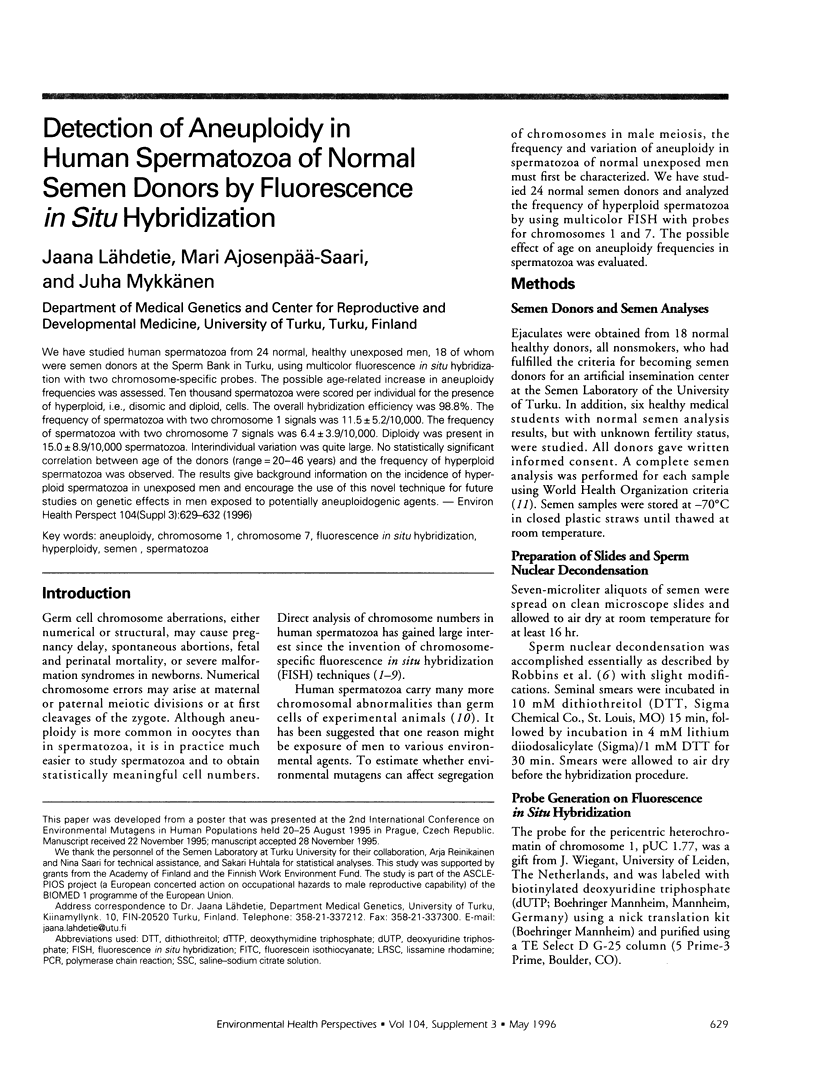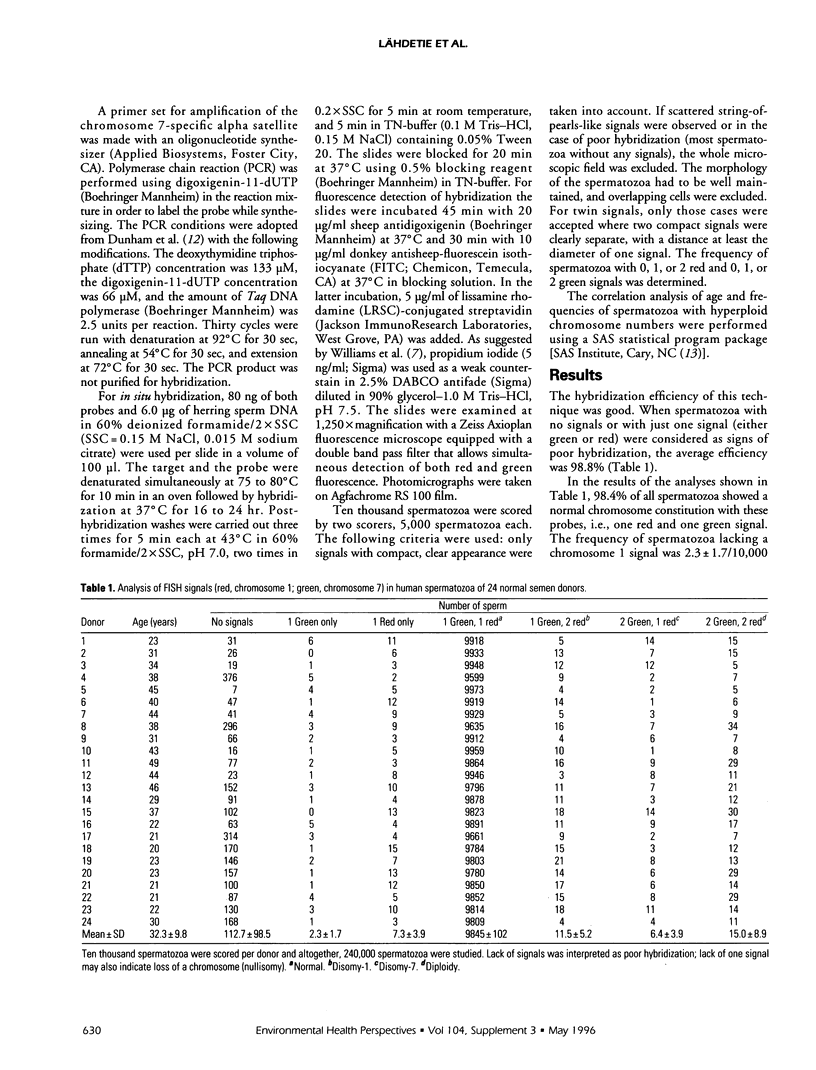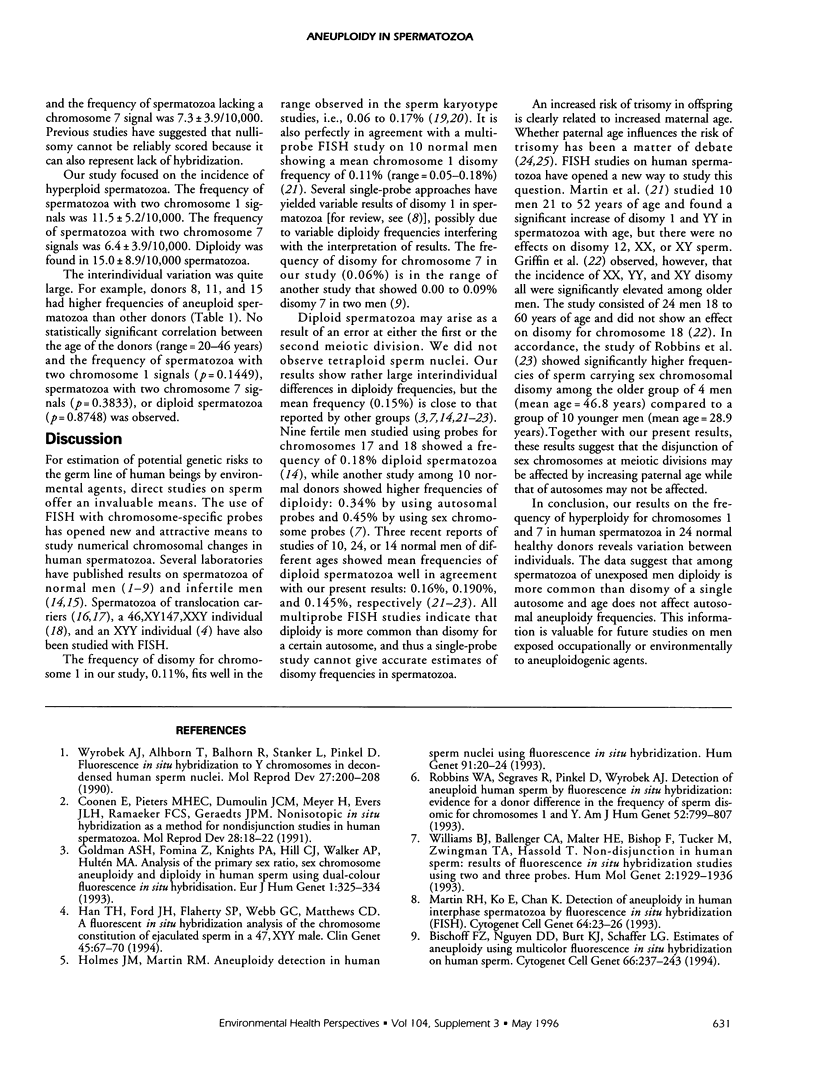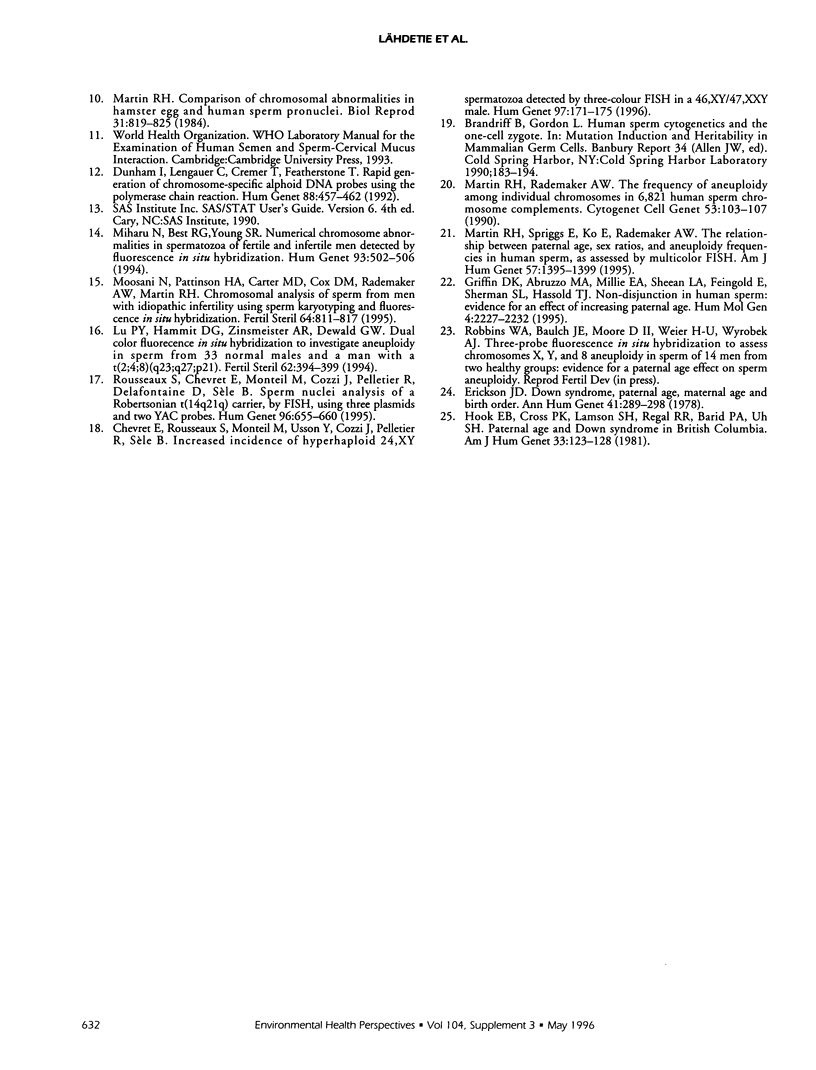Abstract
We have studied human spermatozoa from 24 normal, healthy unexposed men, 18 of whom were semen donors at the Sperm Bank in Turku, using multicolor fluorescence in situ hybridization with two chromosome-specific probes. The possible age-related increase in aneuploidy frequencies was assessed. Ten thousand spermatozoa were scored per individual for the presence of hyperploid, i.e., disomic and diploid, cells. The overall hybridization efficiency was 98.8%. The frequency of spermatozoa with two chromosome 1 signals was 11.5 +/- 5.2/10,000. The frequency of spermatozoa with two chromosome 7 signals was 6.4 +/- 3.9/10,000. Diploidy was present in 15.0 +/- 8.9/10,000 spermatozoa. Interindividual variation was quite large. No statistically significant correlation between age of the donors (range = 20-46 years) and the frequency of hyperploid spermatozoa was observed. The results give background information on the incidence of hyperploid spermatozoa in unexposed men and encourage the use of this novel technique of future studies on genetic effects in men exposed to potentially aneuploidogenic agents.
Full text
PDF



Selected References
These references are in PubMed. This may not be the complete list of references from this article.
- Bischoff F. Z., Nguyen D. D., Burt K. J., Shaffer L. G. Estimates of aneuploidy using multicolor fluorescence in situ hybridization on human sperm. Cytogenet Cell Genet. 1994;66(4):237–243. doi: 10.1159/000133702. [DOI] [PubMed] [Google Scholar]
- Chevret E., Rousseaux S., Monteil M., Usson Y., Cozzi J., Pelletier R., Sèle B. Increased incidence of hyperhaploid 24,XY spermatozoa detected by three-colour FISH in a 46,XY/47,XXY male. Hum Genet. 1996 Feb;97(2):171–175. doi: 10.1007/BF02265260. [DOI] [PubMed] [Google Scholar]
- Coonen E., Pieters M. H., Dumoulin J. C., Meyer H., Evers J. L., Ramaekers F. C., Geraedts J. P. Nonisotopic in situ hybridization as a method for nondisjunction studies in human spermatozoa. Mol Reprod Dev. 1991 Jan;28(1):18–22. doi: 10.1002/mrd.1080280104. [DOI] [PubMed] [Google Scholar]
- Dunham I., Lengauer C., Cremer T., Featherstone T. Rapid generation of chromosome-specific alphoid DNA probes using the polymerase chain reaction. Hum Genet. 1992 Feb;88(4):457–462. doi: 10.1007/BF00215682. [DOI] [PubMed] [Google Scholar]
- Erickson J. D. Down syndrome, paternal age, maternal age and birth order. Ann Hum Genet. 1978 Jan;41(3):289–298. doi: 10.1111/j.1469-1809.1978.tb01896.x. [DOI] [PubMed] [Google Scholar]
- Goldman A. S., Fomina Z., Knights P. A., Hill C. J., Walker A. P., Hultén M. A. Analysis of the primary sex ratio, sex chromosome aneuploidy and diploidy in human sperm using dual-colour fluorescence in situ hybridisation. Eur J Hum Genet. 1993;1(4):325–334. doi: 10.1159/000472431. [DOI] [PubMed] [Google Scholar]
- Griffin D. K., Abruzzo M. A., Millie E. A., Sheean L. A., Feingold E., Sherman S. L., Hassold T. J. Non-disjunction in human sperm: evidence for an effect of increasing paternal age. Hum Mol Genet. 1995 Dec;4(12):2227–2232. doi: 10.1093/hmg/4.12.2227. [DOI] [PubMed] [Google Scholar]
- Han T. H., Ford J. H., Flaherty S. P., Webb G. C., Matthews C. D. A fluorescent in situ hybridization analysis of the chromosome constitution of ejaculated sperm in a 47,XYY male. Clin Genet. 1994 Feb;45(2):67–70. doi: 10.1111/j.1399-0004.1994.tb03996.x. [DOI] [PubMed] [Google Scholar]
- Holmes J. M., Martin R. H. Aneuploidy detection in human sperm nuclei using fluorescence in situ hybridization. Hum Genet. 1993 Mar;91(1):20–24. doi: 10.1007/BF00230216. [DOI] [PubMed] [Google Scholar]
- Hook E. B., Cross P. K., Lamson S. H., Regal R. R., Baird P. A., Uh S. H. Paternal age and Down syndrome in British Columbia. Am J Hum Genet. 1981 Jan;33(1):123–128. [PMC free article] [PubMed] [Google Scholar]
- Lu P. Y., Hammitt D. G., Zinsmeister A. R., Dewald G. W. Dual color fluorescence in situ hybridization to investigate aneuploidy in sperm from 33 normal males and a man with a t(2;4;8)(q23;q27;p21) Fertil Steril. 1994 Aug;62(2):394–399. doi: 10.1016/s0015-0282(16)56896-4. [DOI] [PubMed] [Google Scholar]
- Martin R. H. Comparison of chromosomal abnormalities in hamster egg and human sperm pronuclei. Biol Reprod. 1984 Nov;31(4):819–825. doi: 10.1095/biolreprod31.4.819. [DOI] [PubMed] [Google Scholar]
- Martin R. H., Ko E., Chan K. Detection of aneuploidy in human interphase spermatozoa by fluorescence in situ hybridization (FISH). Cytogenet Cell Genet. 1993;64(1):23–26. doi: 10.1159/000133552. [DOI] [PubMed] [Google Scholar]
- Martin R. H., Rademaker A. The frequency of aneuploidy among individual chromosomes in 6,821 human sperm chromosome complements. Cytogenet Cell Genet. 1990;53(2-3):103–107. doi: 10.1159/000132905. [DOI] [PubMed] [Google Scholar]
- Martin R. H., Spriggs E., Ko E., Rademaker A. W. The relationship between paternal age, sex ratios, and aneuploidy frequencies in human sperm, as assessed by multicolor FISH. Am J Hum Genet. 1995 Dec;57(6):1395–1399. [PMC free article] [PubMed] [Google Scholar]
- Miharu N., Best R. G., Young S. R. Numerical chromosome abnormalities in spermatozoa of fertile and infertile men detected by fluorescence in situ hybridization. Hum Genet. 1994 May;93(5):502–506. doi: 10.1007/BF00202812. [DOI] [PubMed] [Google Scholar]
- Moosani N., Pattinson H. A., Carter M. D., Cox D. M., Rademaker A. W., Martin R. H. Chromosomal analysis of sperm from men with idiopathic infertility using sperm karyotyping and fluorescence in situ hybridization. Fertil Steril. 1995 Oct;64(4):811–817. doi: 10.1016/s0015-0282(16)57859-5. [DOI] [PubMed] [Google Scholar]
- Robbins W. A., Segraves R., Pinkel D., Wyrobek A. J. Detection of aneuploid human sperm by fluorescence in situ hybridization: evidence for a donor difference in frequency of sperm disomic for chromosomes 1 and Y. Am J Hum Genet. 1993 Apr;52(4):799–807. [PMC free article] [PubMed] [Google Scholar]
- Rousseaux S., Chevret E., Monteil M., Cozzi J., Pelletier R., Delafontaine D., Sèle B. Sperm nuclei analysis of a Robertsonian t(14q21q) carrier, by FISH, using three plasmids and two YAC probes. Hum Genet. 1995 Dec;96(6):655–660. doi: 10.1007/BF00210294. [DOI] [PubMed] [Google Scholar]
- Williams B. J., Ballenger C. A., Malter H. E., Bishop F., Tucker M., Zwingman T. A., Hassold T. J. Non-disjunction in human sperm: results of fluorescence in situ hybridization studies using two and three probes. Hum Mol Genet. 1993 Nov;2(11):1929–1936. doi: 10.1093/hmg/2.11.1929. [DOI] [PubMed] [Google Scholar]
- Wyrobek A. J., Alhborn T., Balhorn R., Stanker L., Pinkel D. Fluorescence in situ hybridization to Y chromosomes in decondensed human sperm nuclei. Mol Reprod Dev. 1990 Nov;27(3):200–208. doi: 10.1002/mrd.1080270304. [DOI] [PubMed] [Google Scholar]


